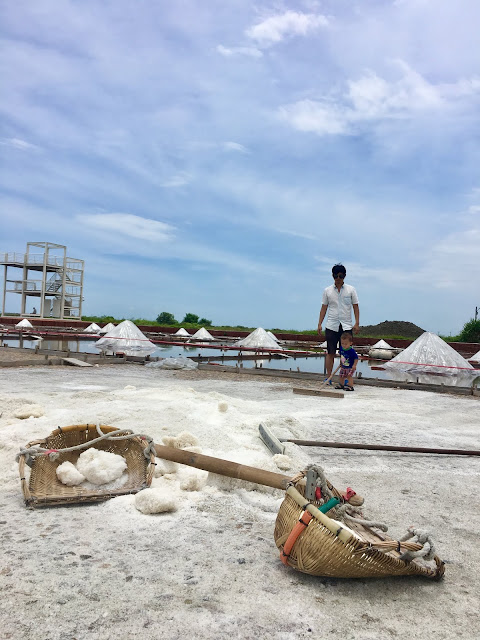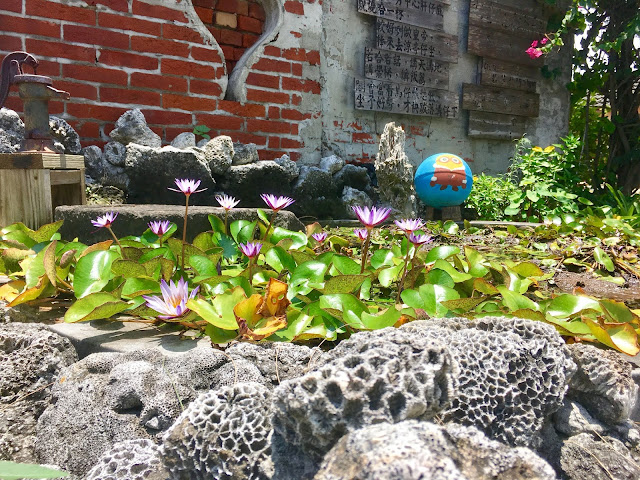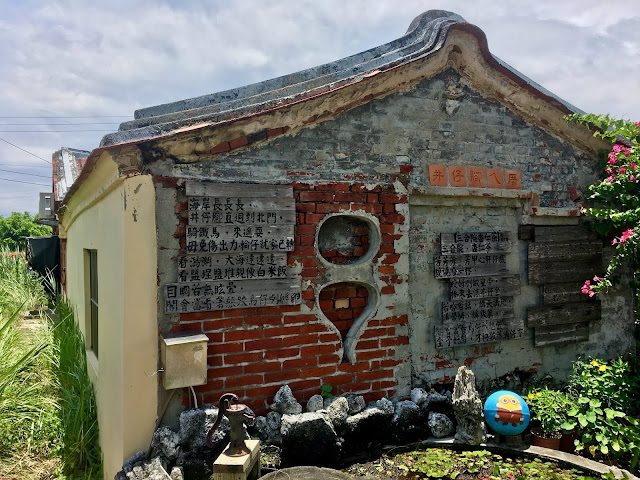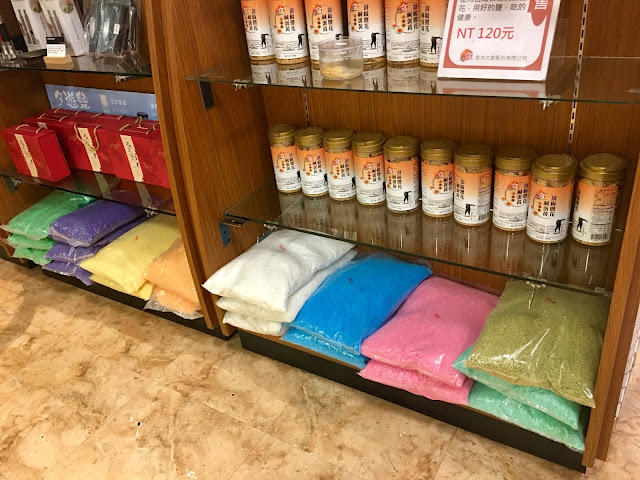Since we are living in Tainan, we are also revisiting places we saw two years ago. This time, we came to the salt fields in Beimen. These salt fields are the oldest manual salt production sites in Taiwan with a 200-year tradition. It's a famous spot for photographers, especially those trying to capture the sunset. The place is open to visitors for free. If you don't go too late, you can also see about three workers there. Although we visited after rainy weather this time, the salt hills were covered, and no one was working there. Also, not many people visited this place this time. It still offered a nice view, but I would highly recommend seeing this place during sunset.
There are also other places dedicated to salt that you can visit in Taiwan: Sio House, Remains of Taiwan Salt Co. in Anping, the Salt Mountain with sculptures, and the Salt Museum in Qigu.
Jingzijiao Wapan Salt Fields (井仔腳瓦盤鹽田)
The first salt fields were built during the Dutch era. In 1648, the Dutch East India Company imported 20 pieces of crushed stone from China and built crystallized pools. They also opened up salt mines, although the salt produced in Taiwan was bitter and couldn't be sold.
In June 1895, Japan began to rule Taiwan. During World War I, with the development of Japanese industry, the demand for industrial salt increased. The Taiwan Governor’s Monopoly Bureau decided to establish a new salt industry in Taiwan in 1919. "Taiwan Salt Co., Ltd." was responsible for salt production, while Dainippon Salt Co., Ltd. was responsible for exporting salt to Japan.
In 1938, the company established the South Japan Salt Industry Co. and was approved to open a total of 6,000 industrial salt fields in Chiayi, Tainan, and Kaohsiung in the same year.
In 1980, the low-capacity salt fields were closed, but the overall trend of salt field area and production in Taiwan was rising. In 1980, it reached the historical peak of the area and output of salt fields in Taiwan, although it could only supply 30% of Taiwan's industrial salt demand. At this time, Taiwan's salt was subject to high prices.
Taiwan's plan to reduce production costs and increase competitiveness was ultimately a failure. The production of salt was limited by Taiwan's climate. In 2002, all salt fields were closed or abandoned. In November of the same year, the official shares were withdrawn from the Taiwan Salt Company, and Taiwan Salt was transformed into a private company.
Originally, the salt fields were established in Fengshan but moved twice due to flooding. It hasn't been relocated since the establishment by salt farmers in the north of Tainan (Beimen) in 1818. It used to be called Yongdong Field. The site was a desert until 1952 when the area was redesigned and became a central-style tiled-paved salt field.
The management office of Yunjianan Binhai National Scenic Area made a lot of effort to attract tourists to this area. They wanted people to experience the tradition of salt making and salt picking.
Salt is made by drawing seawater into salt pans and evaporating it in the sun for 3-5 days. These salt fields are made by manually laying broken debris of pottery and tiles onto the crystallizing pond. This method results in purer and clearer salt being mined. The tiles absorb heat quickly, making salt production quicker in tile-paved salt fields. The process of making salt in sand-paved salt fields is slower but can produce more salt at a lower cost.
While staying there, you can also see a few people working and learn more about this culture. Additionally, you can visit the gift shop, which sells salt in 366 colors and some food items as well.
Hong Guo Residence (井仔學堂)
Hong Guo Residence was built in the traditional three-sided courtyard style during the Japanese occupation period. It has wall foundations made of coral stone, with an open space embellished by the front lane and back screen. Sword lion decorations can still be seen on the gable wall. Later on, the house was bought for 300 NTD by Hong Hui and Hong Chao-bing. Hong Hui got the eastern half and the main hall, while Hong Chao-bing was left with the western half and the land beside the house, where he added another hall. The third-generation owner, Hong Zong-zhi, renovated the entire house in 2008 to serve as his residence in his old age. Part of it was converted into a B&B. An observation platform has been built on the eastern side of the house, perfect for watching the "Sunrise over Mt. Guanzai" and viewing the birds returning to roost in the evening.
Xing'an Temple (興安宮)
Keliaozai was settled by a man named Hong from Keliao around 1818. Most of the villagers are surnamed Hong. Initially, the villagers worshipped at Xingfu Temple, together with the people of Jingzaijiao. Later, in memory of their mother village, they built their own Yingling Temple in 1880. To serve as the host deity of this new temple, they brought in King Chi from Bao'an Temple in Keliao village. Later on, King Ji prompted his worshippers to exchange his place with the host deity of Bao'an Temple, an ancestor brought from China in 1678. In 1981, the temple was rebuilt in the southern style and renamed Xing'an Temple, and its current appearance is the result of a renovation carried out in 2013.


Salt Museum (臺灣鹽博物館)
On the way home, we also stopped by the Salt Museum in Qigu District. After more than ten years of planning, the museum opened in January 2005.
The first-floor exhibition room displays how salt workers worked in the salt fields in Taiwan in the 1960s. The second-floor exhibition room showcases the 30-year history of Taiwan's salt industries. The third-floor exhibition provides information about salt from around the world.
In the building, you can also find a gift shop with salt-themed products, as well as beverages, ice creams, and more.
























0 komentarze:
Post a Comment